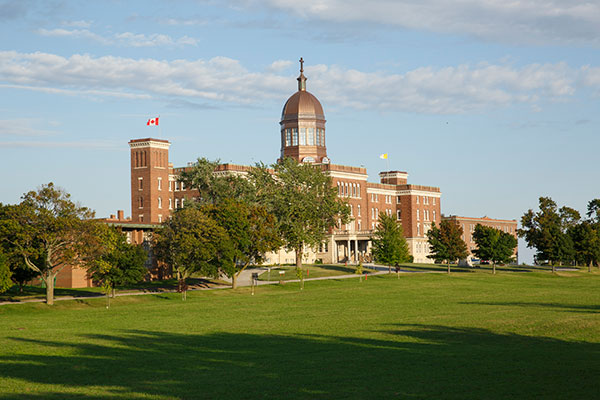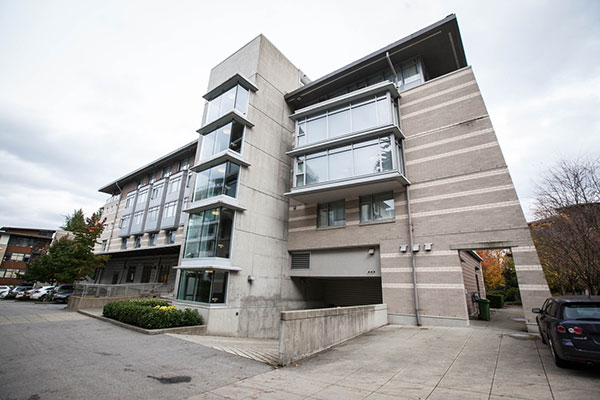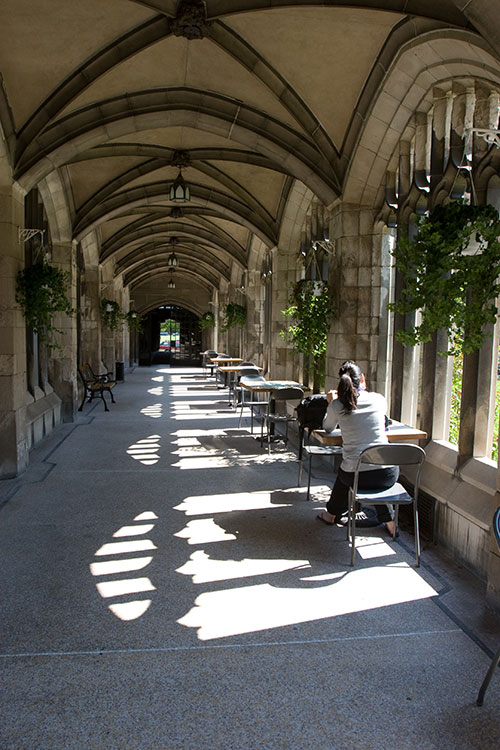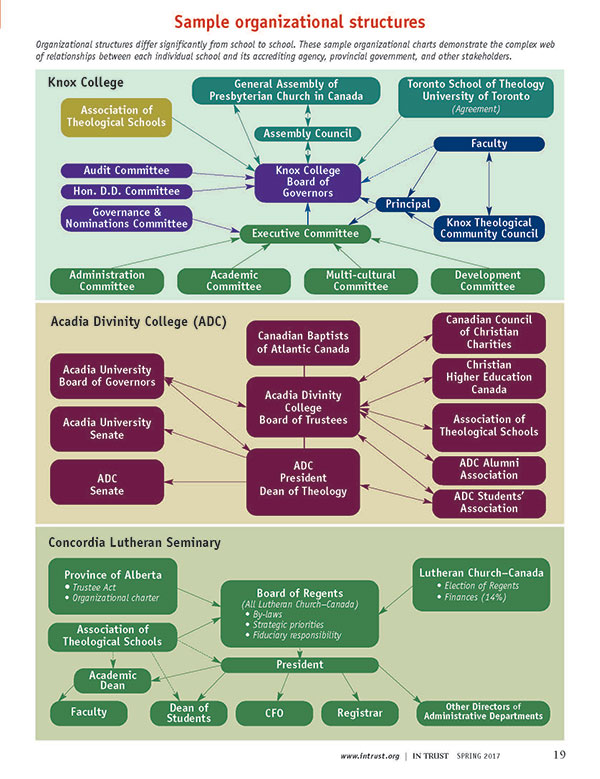 |
Acadia University
Wolfville, Nova Scotia
Credit: Mike Dembeck, Dembeck Photography |
Canada and the United States share a continent, a number of cultural affinities, and more than one similarity in the ways in which they are governed. Both are federal states. Both follow forms of democracy.
In models of governance, however, Canada and the United States may be more different than they are similar. Canada is a constitutional monarchy; the U.S. is a republic. Canada has a parliamentary-cabinet government; the U.S., a president and a bicameral Congress. In Canada, the Queen, represented by an appointed Governor General, is the head of state, while the prime minister is the head of government. In the United States, on the other hand, the elected president is both the head of state and the head of government. Are these national differences reflected in the governance of the nations’ theological schools? Not in the way one might think.
The primary difference between higher education in the two countries is that in Canada, education is a responsibility of the 10 provinces and three territories, and there is no parallel to the U.S. Department of Education nor to the regional accrediting bodies that oversee U.S. higher education. In matters of authorization, funding, and oversight, Canadian education is a provincial, rather than a federal, matter.
The “British North America Act, 1867” (renamed in 1982 as the “Constitution Act, 1867”) states that “in and for each Province, the Legislature may exclusively make laws in relation to Education.” Many Canadian universities and theological schools trace their origins directly to an act or a charter of provincial parliament.
 |
St. Augustine's Seminary
Toronto, Ontario
Credit: Michael Hudson Photography |
For example, Huron University College, one of the oldest university communities in Canada, has a Faculty of Theology that is accredited by the Association of Theological Schools. Huron University College was established in 1863, four years prior to the confederation of Canada, by an act of the Province of Canada (a single province that was subsequently divided into the two provinces of Ontario and Quebec). Carey Theological College, a freestanding denominational school on the University of British Columbia campus, received a provincial charter to grant graduate theological degrees in 1959. Newman Theological College was formed by an act of the Alberta legislature in 1969.
Because higher education is a provincial matter, funding systems differ across the country. Some schools receive public funding from the province in which they are located, while others do not, with this largely being a matter of individual school preference. Factors influencing this decision include the amount of reliance an institution wishes to place on sources that can change from one political administration to the next. Some provinces include performance-based or enrollment-based approaches when deciding how much to fund an institution; other provinces provide lump sums. Formulas differ according to each province’s political administration and financial state.
Like authorization and funding, educational oversight is also a matter of provincial jurisdiction. Each province and territory has a designated governmental department under which the monitoring of schools (whether theological or other) takes place. The contact information for each provincial and territorial department of education can be found at bit.ly/Canada-Educ-Depts.
 |
Carey Theological College
Vancouver, British Columbia
Credit: Carey Theological College |
Provincial governments are taking increasing notice of theological education, and, in some cases, schools that offer graduate-level theological programs need to adhere to provincial quality-assurance requirements and protocols that were not applied to them only a decade ago. Each province employs its own methods of quality assurance — some (like Ontario) with structures and practices of oversight characterized by considerable detail and rigor, and others marked by less granularity. Many provinces publish lists of institutions that meet quality-assurance benchmarks and assessment. Being absent from such a list can make student recruitment more challenging.
Within Canada, and within each province, policies on the awarding of degrees may differ. Most theological schools grant their own degrees. The member schools of the Toronto School of Theology grant their degrees conjointly with the University of Toronto. And, at least in one case, degrees are granted by the university (Acadia University) on behalf of the theological school (Acadia Divinity School).
The particular composition of Canadian higher education, with its institutions mostly formed by legislative charters, results in a multifaceted legacy as well as complex structural realities. A primary example of this complexity is the bicameral form of governance, which is legislated for many universities as well as a number of theological schools.
 |
Newman Theological College
Edmonton, Alberta
Credit: Newman Theological College |
In bicameral institutions, a board of trustees has responsibility for administrative affairs, while a separate senate — composed of faculty, students, academic administrators, and others—is accountable for academic affairs. The senate serves a significant symbolic function for many institutions and is often understood by a theological school as a demonstration of its commitment to broad communication, increased transparency, and shared decision making. From time to time, the senate may function as a holding space for an academic issue until a school is ready to take up the matter. Overall, the purpose and presence of a senate supports stability, ensuring “sober second thought” in all matters related to academic and curricular decision making.
 |
Knox College
Toronto, Ontario
Credit: Joyce Wong |
The bicameral system in general, and the senate in particular, plays an inevitable role in limiting institutional nimbleness. Most large-scale academic changes in bicameral institutions require senate approval. (Depending on the school’s charter, some substantive changes may even require the permission of the provincial legislature!) Such governance structures effectively discourage some alterations and make the amending or dismantling of certain institutional structures and patterns exceptionally difficult. Governance bodies formed to ensure sober deliberation and methodical oversight may be hard pressed to function simultaneously in the nimble and timely fashion required during times of flux, especially in fields that are rapidly changing like educational technology.
The role of the senate can be particularly complicated during seasons of financial pressure. Coordinating a senate’s authority over academic matters with a board’s authority over the purse is complex. Within the senate itself, loyalties and territoriality can make it hard to achieve consensus.
Despite the inherent challenges of the bicameral system, many Canadian theological schools are organized in this way, and some others have another kind of internal locus of authority, such as an academic committee of the board of trustees. A singular model of governance for Canadian schools does not exist. In the case of schools related to denominations, their ecclesial bodies often retain final authority in selected areas. For example, Knox College, a theological school affiliated with the Presbyterian Church in Canada, and Concordia Theological Seminary, a school of the Lutheran Church – Canada, divide decision making between their governing bodies and their denomination or synod, according to defined areas of responsibility. Likewise, the ecclesial bodies for several Catholic schools have authority to ensure that the education conforms with the broader authority of the church, and these bodies sometimes also exercise final authority in matters such as institutional mission and large expenditures. Canadian schools independent of specific religious bodies most often see their boards mandated to exercise ultimate authority over all matters.
A common governance element in Canadian theological education is “Policy Governance,” a leadership paradigm known widely as the “Carver model.” This governance model directs a board of trustees to focus on the largest issues of institutional concern, discourages a board from straying from its appropriate purview (organizational “ends” or purposes) to inappropriate concerns (the “means” of arriving at those ends), and states that the board has a single employee — the president (who in Canada is often called a principal). In institutions that use the Carver model, communication from the board of trustees always flows solely to the president or principal, and through that person to the rest of the institution. Sometimes this clarifies matters, and sometimes it complicates them!
Provincially authorized, funded, and monitored, birthed from acts of legislature that play a role in determining structure, Canadian theological education is distinct from that of its U.S. neighbors. Perhaps just as significantly, Canadian theological education is distinct from one school to another across the country and its 10 provinces.
| Click image to enlarge. |
 |